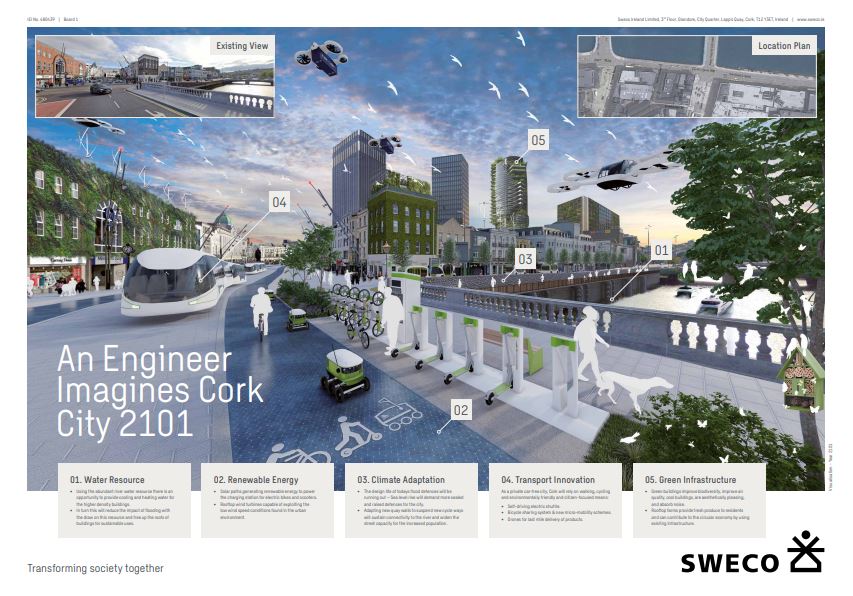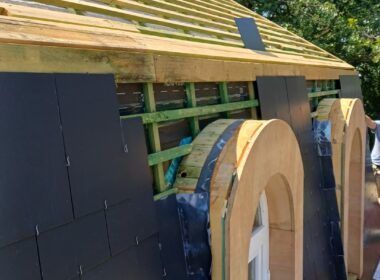Sweco has developed a future study on what Cork City might look like in 80 years’ time, 2101. Our re-imagining takes into consideration climate change mitigation and is powered by innovative, creative and sustainable solutions.
What will it take to transform our throwaway economy into one where waste is eliminated, resources are circulated, and nature is regenerated? The circular economy gives us the tools to tackle climate change and biodiversity loss together, while addressing crucial social needs. It gives us the power to grow prosperity, businesses, jobs, and resilience, while cutting greenhouse gas emissions, waste and pollution. Circular thinking is a systemic approach to economic development designed to benefit businesses, communities, and the environment, based on three principles…
- Design out waste and pollution
- Keep products and materials in use
- Regenerate natural systems
Innovation
Our concept image of Cork City 2101 includes a smart city vision where modern technology and environmentally friendly mobility systems such as driverless or renewable-powered public transport, delivery drones, electric motors, and micro-mobility will be crucial elements.
The aim is for enough power to be produced from renewable sources (i.e. through wind turbines, solar panels, within or close to Cork for it to be resilient, productive, and self-sufficient.). Sustainable buildings will aim to share energy resources, generating as much power as they consume.
Creativity
Mobility is gradually moving away from the ownership-model to the provision-of-service models Mobility as a Service (MaaS). The near future of MaaS will include electric and driverless shuttles and cars.
Autonomous vehicles will accelerate the transition from ‘traditional’ to ’smart’ city, with autonomous and electric shuttles progressively assuming the role of traditional public transportation. With the decreased use of privately owned cars and the increased deployment of these shuttles, high emission levels and congestion on transportation infrastructure will be reduced. This will not only alter the transportation infrastructure but also the city architecture. Our target is for Cork City centre to be free of private vehicles.
Unmanned aerial vehicles (UAV or drones) and evolving legislation may soon open the way for their large-scale implementation in the last mile delivery of products. The use of drones could drastically decrease labour costs and has been hyped as a replacement for the parcel delivery industry.
Remotely programmed drones will become large and powerful enough to transport people within the city. These eco-friendly and intelligent autonomous aerial vehicles provide short-and-medium-haul transportation solution for the future intelligent transportation.
The pods will operate as a mass transportation system that shuttles peoples from door-to-door. They will pick passengers up on demand.
This was a fun and thought-provoking study to work on across our many Sweco disciplines – and we’re proud to have been recognised for this exciting vision with third prize at the ‘An Engineer Imagines Cork City 2101’ run by Engineers Ireland.
Tara O’Leary Technical Director at Sweco Ireland
Sustainability
The future is sustainable. It can be seen in the National Planning Framework (NPF) and National Development Plan 2021-2030 – these combine to form Project Ireland 2040 produced by the Government of Ireland. In October 2021, Eamon Ryan (Minister for Environment, Climate, Communications & Transport) stated:
“This is a plan for a cleaner, greener, connected Ireland, a plan that supports communities and our climate goal – to cut emissions in half by 2030 – and creates a new green and digital economy.”
Sustainable mobility is a National Strategic Outcome of the NPF. The National Development Plan makes provision for investment in attractive public transport alternatives to car transport to reduce congestion and emissions and enable the transport sector to cater for the demands associated with longer-term population and employment growth in a sustainable manner.
Our concept image of Cork City 2101 is consistent with Project Ireland 2040 with the following sustainable mobility amenities:
- Enhanced walking and cycling facilities. Most of these facilities will be equipped with solar panels and photovoltaic cells capable of generating renewable energy.
- A high level wood and steel suspended cycleway along the River Lee.
- The public transport will be formed by an electric floating bus.
- Electric bike and scooter sharing systems will be provided around the city.
- Private cars will be removed from the city centre and public transport, bicycles, scooters and walking will be the preferred options
Ethical
An important pillar of our concept of Cork City 2101 is inclusive design. Cork will become an inclusive city, which provides opportunities and better living conditions for all. This is a key factor in the development of a positive society.
Inclusive design involves the construction of urban centres to provide safe spaces for caregivers and the installation of wheelchair-accessible devices for persons with disabilities. It includes accessible locations for the elderly, making Cork more appealing to the older generation. Our design of Cork creates greener and safer neighbourhoods for all residents and invests in happy and safe spaces for children to play.
Environment & Healthy City
Green spaces are increasingly important in urban areas for both the ecosystem and human health. It has been proven that green areas in urban environments improve mental and physical health. The introduction of green spaces in urban areas, particularly trees and canopy layers, can improve air quality (resulting in fewer pollution related illnesses and deaths). Plants can also act as carbon sinks, reducing the amount of CO2 in cities.
Cities are generally warmer than rural areas due to anthropogenic activities, concrete structures, and narrow streets. This leads to the use of energy to cool buildings. Hard street surfaces retain heat which, in turn, heats surface water run-off into urban water bodies disrupting the existing ecosystem. Introducing green roofs and planted ground level areas reduces surface temperatures, reducing the impact on the environment and reducing energy consumption for cooling buildings. The planted areas will also retain water from rainfall, resulting on less stress to the drainage system. The introduction of native plant species in the urban environment will result in a more diverse biodiversity of insects, birds, and other animals in the city.
With global population growing, pressures are being put on the food chain, which will likely impact on food availability in large cities in the future. We expect rooftop gardens and farms to become a favourite amongst city dwellers. Growing food in cities will reduce transport costs and emissions, decrease food waste, utilise rainwater, support biodiversity and reduce food costs. Combined, these factors will result in healthier cities.
Our concept image of Cork City 2101 includes the future proofing of Cork City to reduce the impact of flooding. This is consistent with the sequential approach in present day guidelines and recognises the need for a review of considerations for Climate Change as the present day proposals for flood relief will be expected to have outlived their design life by 2101.
The Lower Lee Flood Relief Scheme (LLFRS) proposals for Cork City at the location of our key image, proposes new/modified quay walls for 50m from the bridge in the background of the image (Christy Ring Bridge). Further downstream, Cork City is anticipated to be above the current forecasted flood levels. As the end of the design life of the LLFRS approaches, the implications of Climate Change will be revisited.
Our concept acknowledges this and allows for further defence systems incorporated into the extended sealed and raised quay wall for example with pedestrian/cycle path keyed into the wall. This will also serve to enhance and expand the amenity capacity/connection with the river in the City. Further, the concept design proposes to extract river water beneath the walkway using heat pumps for use for cooling and heating of buildings, which will further reduce the impacts of flooding. This alternative cooling systems would leave roof tops free for alternative energy generation and sustainable amenities to enable future buildings to be self-sufficient.
Social & Cultural
Project Ireland 2040 predicts a significant population and employment growth of 50-60% in Cork City and the suburban area. Developing buildings vertically allows for more space and more people. The land available for buildings is finite, and while tall buildings have a height limit, cities and towns can better utilize this space by building more tall, vertical buildings. Therefore, the development of taller buildings is inevitable.
In order to obtain a sustainable urban environment, green buildings are proposed on our concept of Cork City 2101. Rooftop gardens and vertical gardens in office, residential and public buildings with pollinator friendly species are included to provide residents with fresh produce and enhanced social spaces.

Author: Sweco
Illustration: Sweco’s senior visualisation & graphics consultant Will Fox brings Cork City of the future to life
Read also: From now on, architecture must (absolutely) be inspired by nature; Using electrical engineering for energy transition; ORI highlights the role of consultancy and engineering firms in Brussels; Agglomerated stone and digital manufacturing techniques to restore heritage buildings; For responsible builders.





